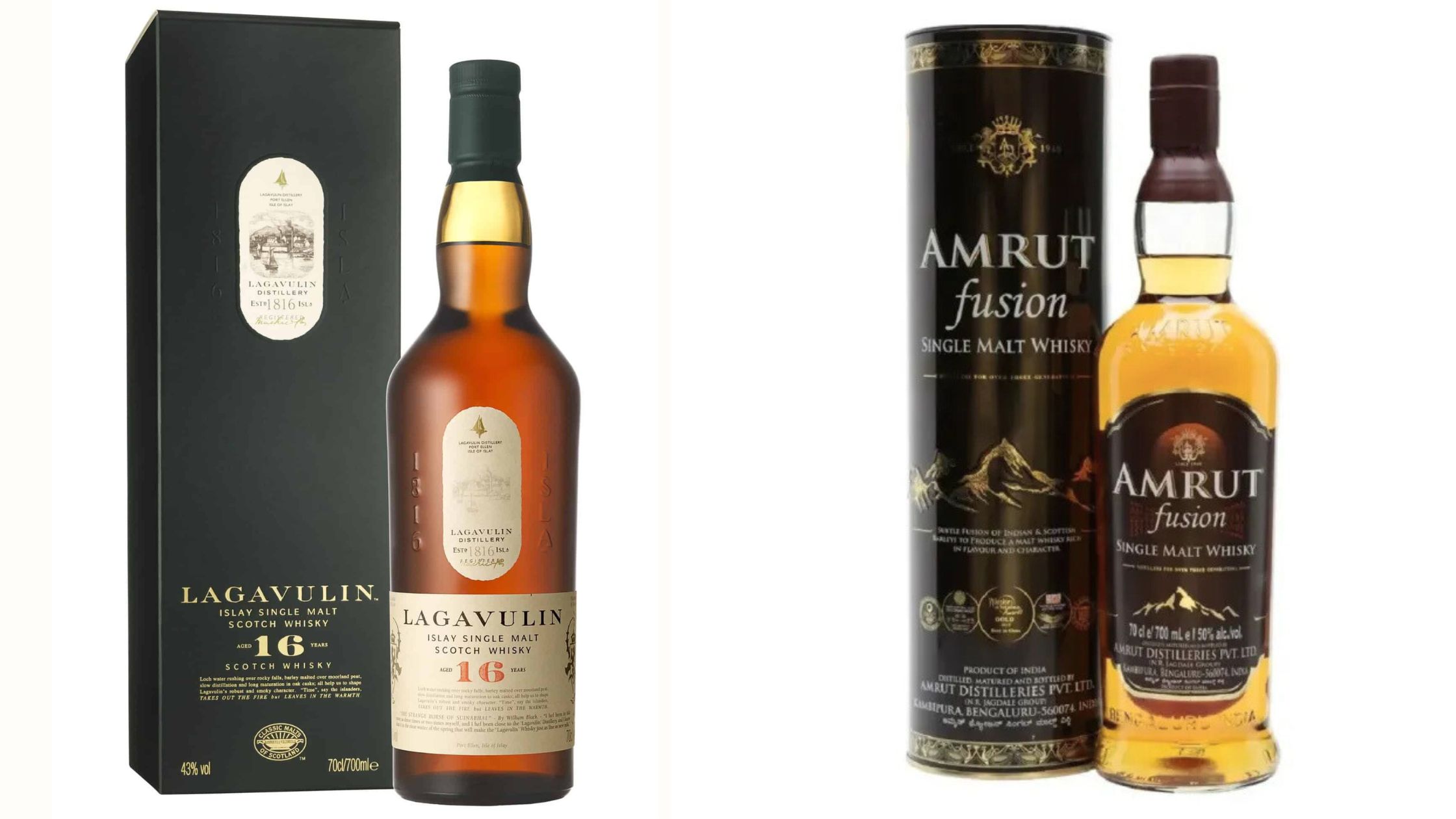Best Liquor Under ₹10,000 for a Perfect New Year 2026 Party
2025-12-05


Single malt whisky is in an exciting new phase of its existence. No longer representative of just a handful of regions in Scotland, it is now produced globally—sometimes with artisanal skill and love from Japan, sometimes from Taiwan, sometimes from the United States, and yes, sometimes from India! In two whiskies that most represent this new whisky world, we can see the dystopia and the utopia. Lagavulin 16 from Islay, Scotland, represents distilled tradition from a windswept isle; Amrut Fusion, from Bangalore, India, represents demolishing ceilings in a rain-washed, fiery urban center.
Though they come from different ends of the transnational whisky spectrum, few whiskies in the world today command more respect than these two.
In this deep dive, we’ll compare taste profiles, distillery histories, production methods, expert reviews, pricing, and unique strengths—giving you the insights to choose your perfect pour.
The Lagavulin distillery has claimed a quality stamp on its product since 1816, but long before that the process of whisky-making occurred—including illicitly. Situated on the southern coast of Islay, overlooking the Atlantic Ocean, the casks are apparently preserved with salty wind and sea spray.
The style of Lagavulin is characterized by heavily peated malt (roughly 35–40 ppm phenols) and long, slow distillation in the distillery's distinctive pear-shaped stills. The slow process and the extended maturation—most often in used/saturated, ex-sherry casks—produces the thick, oily, and smoky-sweet character whisky lovers so admire.
For many whisky devotees, Lagavulin 16 was the dram that defined Islay whisky. It has been part of Diageo's Classic Malts range since 1988, and remains a "bucket list" bottle for peat-heads.
In 1948, mere months from India's independence, Amrut Distilleries got its name from the eternal beverage of the Gods. Amrut made fine rum and brandy until they decided to put aside these traditions during the 1980s and start experimenting with malt whisky production. By the early 2000s they were refining and perfecting the process. Their first product was Amrut Single Malt, which gained international attention from critics, many of whom were astonished by its quality and taste.
In 2009, distilleries released Amrut Fusion, a bold declaration regarding their product and its ingredients. Amrut Fusion was a whisky constructed from 50% Indian barley sourced from the Himalayan foothills and 50% peat barrel Scottish barley from Scotland, aged together in hot dry Bangalore. When they named their product Fusion, they were referring to the origins of the key barley ingredients, as well as the fusion of styles of whisky: rich tropical fruit, a bold spice element, and a restrained smoky backbone.
Climate is one of the biggest differences between these two whiskies—and one of the main reasons they taste so different.
Lagavulin's casks are stored in cool, damp warehouses by the sea. The "angel's share" (evaporation rate) is around 1.5-2% per year. Over 16 years, it will go through oxidation and interaction with the wood to soften the peat, deepen the sweetness, and create layered complexity, which Lagavulin is known for.
The climate in Bangalore is almost the opposite—it is hot with low humidity. The angel's share, here, could be 10–12% each year. Which means a whisky like Amrut Fusion, aged only 4–5 years, can have a flavor concentration similar to much older Scotch due to the climate. However, this shorter maturation time tends to be fresher and fruitier (as opposed to the rounder, more mellow Scotch character).
Here’s how these two single malts compare in the glass:
|
Attribute |
Lagavulin 16 |
Amrut Fusion |
|
Region |
Islay, Scotland |
Bangalore, India |
|
ABV |
43% |
50% |
|
Nose |
Dense peat smoke, honey, iodine, ocean spray, melon, and subtle dried fruit from sherry casks |
Ripe mango, plum, raspberry, floral notes, caramel, vanilla, gentle peat |
|
Palate |
Rich sherry sweetness, soft yet powerful smoke, malt, oak spice, salty tang, chewy and oily texture |
Syrupy tropical fruits (mango, peach), raisins, vanilla, brown sugar, pepper, moderate earthy peat |
|
Finish |
Long, complex, smoky-spicy with nutty-earthy undertones and a drying effect |
Medium length, peppery fruit, lingering sweet peat and caramel |
|
Balance |
Perfect harmony between smoke and sweetness; considered a “benchmark” Islay |
Juicy fruit balanced with peat and spice; approachable despite high ABV |
|
Complexity |
Evolves beautifully in the glass; layers reveal themselves over time |
Vibrant and multi-layered, especially given its youth |
The Role of Peat
Peat is a defining element in both whiskies, but the source and application differ.
Expert & Enthusiast Reviews
Lagavulin 16
Amrut Fusion
Price Comparison: India vs Global Markets
|
Whisky |
India Price (750ml) |
International Average |
|
Lagavulin 16 |
₹11,900–₹13,050 |
$95–$141 |
|
Amrut Fusion |
₹3,600 |
$74–$78 |
Key takeaway: In India, Lagavulin costs three times as much as Amrut Fusion. Globally, the gap narrows, but Lagavulin still commands a prestige premium.
Value for Money
Lagavulin 16 is priced as a luxury single malt. You’re paying for age, brand heritage, and complexity. For many peat lovers, it’s worth every rupee or dollar.
Amrut Fusion offers exceptional value: high ABV, bold flavors, award-winning pedigree, and unique production methods at a fraction of the price.
Unique Strengths
Lagavulin 16
Amrut Fusion
Food Pairing Recommendations
Lagavulin 16
Amrut Fusion
Which One Should You Buy?
The Bigger Picture – What This Comparison Tells Us
This isn’t just about two bottles—it’s about how terroir, tradition, and technology create radically different experiences in whisky.
Final Verdict
Both Lagavulin 16 and Amrut Fusion are world-class whiskies. Choosing between them isn’t about which is “better” but about which speaks to your mood, palate, and budget.
If you can, try them side-by-side. It’s a tasting experience that feels like travelling from Scotland’s stormy shores to India’s sunlit plains in two sips.
Read Also: The World’s Strongest Liquors: Exploring the Highest Alcohol Content Spirits